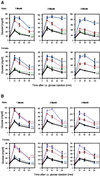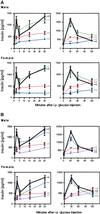Profound defects in pancreatic beta-cell function in mice with combined heterozygous mutations in Pdx-1, Hnf-1alpha, and Hnf-3beta
- PMID: 11904435
- PMCID: PMC122607
- DOI: 10.1073/pnas.062605899
Profound defects in pancreatic beta-cell function in mice with combined heterozygous mutations in Pdx-1, Hnf-1alpha, and Hnf-3beta
Abstract
Defects in pancreatic beta-cell function contribute to the development of type 2 diabetes, a polygenic disease that is characterized by insulin resistance and compromised insulin secretion. Hepatocyte nuclear factors (HNFs) -1alpha, -3beta, -4alpha, and Pdx-1 contribute in the complex transcriptional circuits within the pancreas that are involved in beta-cell development and function. In mice, a heterozygous mutation in Pdx-1 alone, but not Hnf-1alpha(+/-), Hnf-3beta(+/-), or Hnf-4alpha(+/-), causes impaired glucose-stimulated insulin secretion in mice. To investigate the possible functional relationships between these transcription factors on beta-cell activity in vivo, we generated mice with the following combined heterozygous mutations: Pdx-1(+/-)/Hnf-1alpha(+/-), Pdx-1(+/-)/Hnf-3beta(+/-), Pdx-1(+/-)/Hnf-4alpha(+/-), Hnf-1alpha(+/-)/Hnf-4alpha(+/-), and Hnf-3beta(+/-)/Hnf-4alpha(+/-). The greatest loss in function was in combined heterozygous null alleles of Pdx-1 and Hnf-1alpha (Pdx-1(+/-)/Hnf-1alpha(+/-)), or Pdx-1 and Hnf-3beta (Pdx-1(+/-)/Hnf-3beta(+/-)). Both double mutants develop progressively impaired glucose tolerance and acquire a compromised first- and second-phase insulin secretion profile in response to glucose compared with Pdx-1(+/-) mice alone. The loss in beta-cell function in Pdx-1(+/-)/Hnf-3beta(+/-) mice was associated with decreased expression of Nkx-6.1, glucokinase (Gck), aldolase B (aldo-B), and insulin, whereas Nkx2.2, Nkx-6.1, Glut-2, Gck, aldo-B, the liver isoform of pyruvate kinase, and insulin expression was reduced in Pdx-1(+/-)/Hnf-1alpha(+/-) mice. The islet cell architecture was also abnormal in Pdx-1(+/-)/Hnf-3beta(+/-) and Pdx-1(+/-)/Hnf-1alpha(+/-) mice, with glucagon-expressing cells scattered throughout the islet, a defect that may be connected to decreased E-cadherin expression. Our data suggest that functional interactions between key islet regulatory factors play an important role in maintaining islet architecture and beta-cell function. These studies also established polygenic mouse models for investigating the mechanisms contributing to beta-cell dysfunction in diabetes.
Figures





Similar articles
-
Loss of HNF-1alpha function in mice leads to abnormal expression of genes involved in pancreatic islet development and metabolism.Diabetes. 2001 Nov;50(11):2472-80. doi: 10.2337/diabetes.50.11.2472. Diabetes. 2001. PMID: 11679424
-
A pancreatic beta -cell-specific enhancer in the human PDX-1 gene is regulated by hepatocyte nuclear factor 3beta (HNF-3beta ), HNF-1alpha, and SPs transcription factors.J Biol Chem. 2001 May 18;276(20):17533-40. doi: 10.1074/jbc.M009088200. Epub 2001 Feb 5. J Biol Chem. 2001. PMID: 11278466
-
beta-cell genes and diabetes: quantitative and qualitative differences in the pathophysiology of hepatic nuclear factor-1alpha and glucokinase mutations.Diabetes. 2001 Feb;50 Suppl 1:S101-7. doi: 10.2337/diabetes.50.2007.s101. Diabetes. 2001. PMID: 11272165
-
A genetic switch in pancreatic beta-cells: implications for differentiation and haploinsufficiency.Diabetes. 2002 Aug;51(8):2355-62. doi: 10.2337/diabetes.51.8.2355. Diabetes. 2002. PMID: 12145145 Review.
-
Different genes, different diabetes: lessons from maturity-onset diabetes of the young.Ann Med. 2002;34(3):207-16. Ann Med. 2002. PMID: 12173691 Review.
Cited by
-
Vascular endothelial growth factor-mediated islet hypervascularization and inflammation contribute to progressive reduction of β-cell mass.Diabetes. 2012 Nov;61(11):2851-61. doi: 10.2337/db12-0134. Epub 2012 Sep 6. Diabetes. 2012. PMID: 22961079 Free PMC article.
-
Development of novel cell lines of diabetic dysfunction model fit for cell-based screening tests of medicinal materials.Cytotechnology. 2013 Jan;65(1):105-18. doi: 10.1007/s10616-012-9466-x. Epub 2012 Jul 10. Cytotechnology. 2013. PMID: 22777586 Free PMC article.
-
Pleiotropic Roles of PDX-1 in the Pancreas.Rev Diabet Stud. 2007 Winter;4(4):209-25. doi: 10.1900/RDS.2007.4.209. Epub 2008 Feb 10. Rev Diabet Stud. 2007. PMID: 18338074 Free PMC article.
-
Distinct roles for insulin and insulin-like growth factor-1 receptors in pancreatic beta-cell glucose sensing revealed by RNA silencing.Biochem J. 2004 Jan 1;377(Pt 1):149-58. doi: 10.1042/BJ20031260. Biochem J. 2004. PMID: 14563207 Free PMC article.
-
Monogenic Diabetes Modeling: In Vitro Pancreatic Differentiation From Human Pluripotent Stem Cells Gains Momentum.Front Endocrinol (Lausanne). 2021 Jul 6;12:692596. doi: 10.3389/fendo.2021.692596. eCollection 2021. Front Endocrinol (Lausanne). 2021. PMID: 34295307 Free PMC article. Review.
References
-
- Edlund H. Diabetes. 2001;50, Suppl. 1:S5–S9. - PubMed
-
- Shih, D. Q. & Stoffel, M. (2002) Curr. Diabetes Rep. 2, in press. - PubMed
-
- St-Onge L, Wehr R, Gruss P. Curr Opin Genet Dev. 1999;9:295–300. - PubMed
-
- Sander M, Sussel L, Conners J, Scheel D, Kalamaras J, Dela Cruz F, Schwitzgebel V, Hayes-Jordan A, German M. Development (Cambridge, UK) 2000;127:5533–5540. - PubMed
Publication types
MeSH terms
Substances
Grants and funding
LinkOut - more resources
Full Text Sources
Other Literature Sources
Molecular Biology Databases
Miscellaneous

